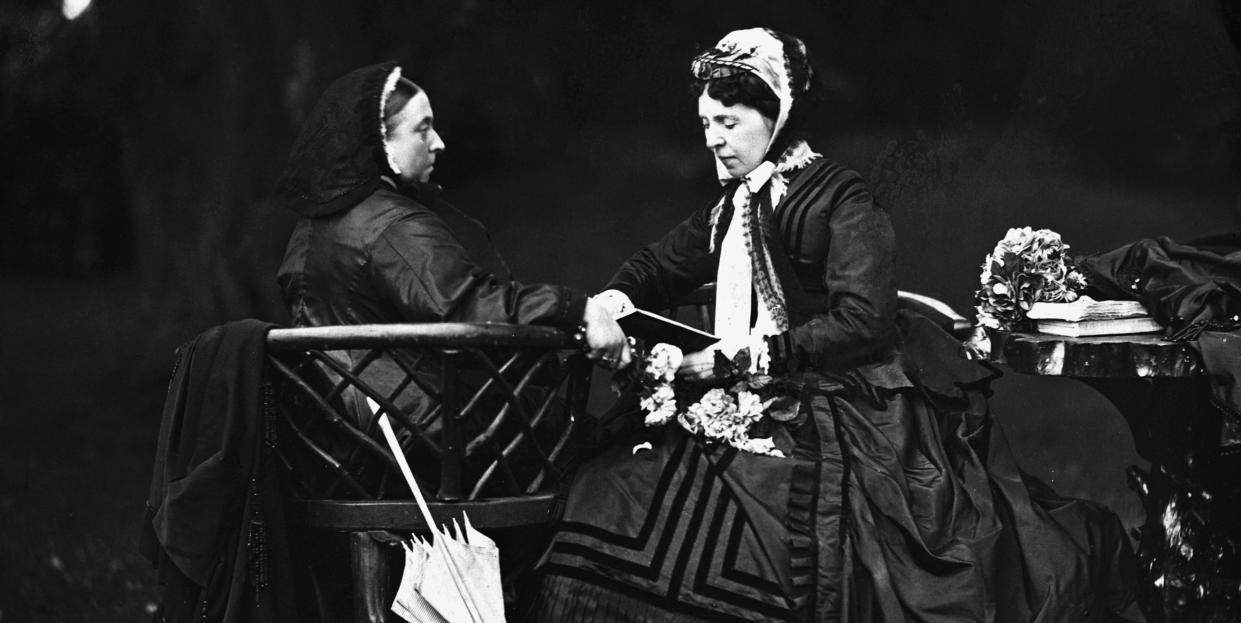What's Inside the Recently Uncovered Private Letters of Queen Victoria?

In 2018, The Neues Palais—the last palace built by Frederick the Great in Potsdam, Germany—hosted a small exhibition called “Kaiserdämmerung” (“The Twilight of the Emperor”), to mark the centenary of Kaiser Wilhelm II’s abdication as Emperor and King of Prussia. While preparing for the exhibition, curators made a startling discovery in the dressing room of Wilhelm’s wife, Empress Augusta Victoria (pictured above with her great aunt, Queen Victoria).
“In the former boudoir of Augusta Victoria there is a steel safe built in the wall in a small cabinet,” says Dr. Samuel Wittwer, director of the Prussian castles. “There are no keys and no one from the former or present palace staff ever saw it open. As we were preparing for the exhibition on the end of the monarchy, we were curious to see if our experts could open it.”
The curators tried but failed to get past the steel door. They happened to spot a second, much smaller door above the steel door which looked very much the same. “It was unreachable without a ladder, which would have been difficult to use in such a tight space anyway,” says Wittwer. “Because the second door was only wood, the lock was much more simply made. Opening this lock was rather easy.”

In the secret cabinet behind it, curators came upon two oak boxes, a leather case, and a folder of documents. Approximately 1,000 letters written to the Empress were found. “One of the boxes–last locked in 1886–was slightly broken,” says Wittwer. Experts found letters dating from 1883 to 1886, including from Augusta Victoria’s predecessor, Kaiserin Augusta.
The second box, which has yet to be opened, bears a label describing the contents as letters about her sons. Also unopened is a sheaf of letters from Augusta Victoria’s great-aunt and godmother, Queen Victoria of England, found in the leather case. “Queen Victoria is included,” says Wittwer with an air of mystery. “As far as we can see as of yet, the senders were mainly relatives and leading staff.”

According to the addresses on the boxes, Wittwer believes that the letters were transported from the Berlin Schloss to the Neues Palais when Wilhelm II and Augusta Victoria moved there. “To be sure that no one would read these private letters, the letters were packed in envelopes according to the people who wrote them and then sealed,” says Wittwer. “Some of the envelopes show the name of the writer of the letters inside, but the envelopes are still sealed. The two wooden boxes were corded—and the strings sealed as well—but one box had been opened once.” In this box, Wittwer says that very few of the seals of the envelopes had been broken and opened, which indicated the amount of letters in total. “We do not yet have information on what the letters are about. The letters are addressed to Augusta Victoria while she was still Crown Princess.”
The Palace’s plan was to publish the letters online on April 11, 2021, in time for the centenary of Augusta Victoria’s death, says Jörg Kirschstein, a curator of the 2018 exhibition as well as manager of Neues Palace. “Unfortunately, there is a question of the ownership of the letters which has not yet been resolved.”
There is still a discussion of rights between the family of Hohenzollern—the former royal German dynasty—and the palace, adds Wittwer. “According to the 1926 law, separating the property of the Hohenzollern family from the property of the state, one rule was, that all items—with some small exceptions—in the private apartments of the former Emperor and his wife became their property. They had the chance to remove them and bring them into exile with them in the Netherlands. After this, what was left in the palace became public property.”
When curators found the letters, the question came up whether they belong to the family or to the state. “But because of the complicated history of the eastern part of Germany all these property-questions are not as easy as they look,” says Wittwer.

Kirschstein notes that for now, we will have to be patient. “But the letters are to be published,” he says.
Wittwer is looking forward to learning about Empress Augusta Victoria. “Like many other female members of the Hohenzollern family, Auguste Victoria stood in her husband's shadow,” he says. “Few books and exhibitions tried to show her as a historic person in her own right. The historical portrayal of her from the 19th and early 20th centuries still dominate royal history.” Wittwer says that in comparison to other Hohenzollern family members, very little is known about the Empress as a young woman. “But we hope that 2021’s public release of the letters will change that.”
You Might Also Like


